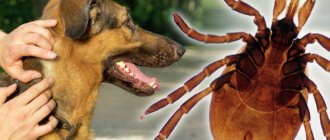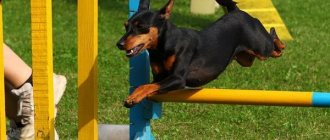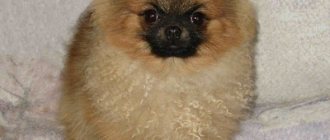5 / 5 ( 1 voice )
Conjunctivitis is a lesion of the eye, namely the conjunctiva (inner mucous membrane). The disease rarely appears as an independent process. Often, the problem is a consequence of untreated chronic pathology or the progressive development of an infection in the dog’s body.
Causes of conjunctivitis in dogs
We can say that the disease is closely related to immunity deficiency. Pathogenic microorganisms enter the eye from the air, penetrate the conjunctiva and cause an inflammatory process if the body does not resist.
There are breeds that are at risk and prone to conjunctival inflammation. First of all, these are dogs with long hair: Yorkshire terriers, lapdogs, poodles, spaniels. The second group of animals are with large round eyes: Pekingese, Chihuahuas, pugs, bulldogs. Also, frequent inflammation of the mucous membrane is typical for dogs with an open lower eyelid: Alabai, Basset Hounds. And the last group is genetically predisposed dogs: Dobermans, Great Danes.
Other causes of conjunctivitis:
- Mechanical (ingress of sand, dust, small debris, eye injury, bruise);
- Contact with smoke, chemical vapors or liquid substances (detergents, shampoos, toothpastes);
- Dermatological problems affecting the skin of the eyelids;
- Burns, frostbite;
- Ingrown eyelashes;
- Fungal or viral infections;
- Metabolic disease;
- Allergic reaction to pollen or food;
- Vitamin deficiency;
- Constant hair getting into the eyes, causing excessive tearing;
- Age-related eye diseases.
What is keratoconjunctivitis sicca in dogs?
Keratoconjunctivitis is a disease accompanied by an inflammatory process in the cornea and conjunctiva. The pathology is characterized by a decrease in the amount of tears, the main function of which is to moisturize the surface of the cornea and conjunctiva. In severe cases, fluid production stops completely.
Dry eye syndrome can be:
- Innate. It occurs in puppies from the first weeks of life, as a rule, as a result of intrauterine abnormalities.
- Acquired. Develops at any age for various associated reasons.
Based on the nature of the process, the following are distinguished:
- Spicy. The tears stop producing abruptly, and within a few days the condition worsens significantly.
- Chronic. The process lasts for several months and even years.
Types and symptoms of the disease with photos
First of all, the disease can be divided into 2 types: primary, when the cause of the problem lies on the surface (eye injury, sand ingress, etc.), secondary, when conjunctivitis develops due to infection (distemper, adenovirus, hepatitis).
The general classification divides conjunctivitis in dogs into 4 types. Each of them has its own causes, symptoms, course, treatment and complications.
Follicular conjunctivitis in dogs
A chronic breed disease, often found in dogs with drooping lower eyelids . It is characterized by inflammation of the third eyelid due to enlargement of the gland, the appearance of follicles (small bubbles with liquid). It is treated either with antibiotic ointments and drops, or with surgery.
Symptoms of follicular conjunctivitis:
- Itching, lacrimation, whitish or yellowish purulent discharge;
- Swelling of the eyelid and conjunctiva, redness;
- Dried crusts on the surface of the eyelids and eyelashes;
- Pain, swelling of the eye, closure of the palpebral fissure;
- Photophobia;
- Increased body temperature.
Long-term untreated follicular conjunctivitis can lead to blindness.
Catarrhal
This type of conjunctivitis is the mildest and is often caused by eye injury or an allergic reaction. Its danger lies in the fact that without comprehensive treatment, a mild form develops into a chronic form with regular exacerbations. Symptoms of catarrhal conjunctivitis:
- Redness of the mucous membrane and eyeball (after injury, burst blood vessels may appear);
- Swelling of the eyelid;
- Mucous clear or whitish discharge;
- Profuse lacrimation;
- Symptoms of allergic reactions may occur.
Purulent conjunctivitis
Purulent discharge often indicates the appearance of a pathogenic microorganism . This type of conjunctivitis appears as a symptom of infection with canine distemper, an adenovirus. In this case, the pet will be contagious both to its fellows and to humans. But sometimes suppuration occurs due to blepharitis, trichiasis, keratitis (inflammation of the cornea of the eye). The most “harmless” reasons are ingrown eyelashes and large eye openings.
Symptoms of the disease:
- Purulent yellow or greenish discharge, accumulations in the corners of the eyes;
- There may be an unpleasant odor;
- Increased body temperature;
- Redness of the eyelids;
- Photophobia.
This form of conjunctivitis requires veterinary intervention to determine the cause. If the problem lies in an infectious infection of the body, then the treatment regimen will be built around destroying the virus and restoring the immune system.
A rare form - dry keratoconjunctivitis appears due to insufficient tear production. Often, the disease is a consequence of untreated keratitis or conjunctivitis. Manifested by symptoms: clouding of the cornea, dry mucous membrane, yellowish viscous discharge.
Purulent conjunctivitis in puppies
A separate type of conjunctivitis, which is also called physiological ankyloblepharon. Appears in puppies that have not yet opened their eyes. The main reason is an infectious disease in the female who gave birth or intrauterine pathologies. Characteristic symptoms are swelling of the closed eyes and accumulation of whitish discharge in the corners.
The problem requires special treatment:
- Opening the eye surgically (less often manually);
- Cleansing from pus with herbal decoctions (chamomile);
- Lubrication with antibacterial ointment (veterinarian consultation required).
Allergic
This type of conjunctivitis occurs when an allergen (dust, pollen) gets into the mucous membrane or cornea of the eye. Symptoms differ from the typical form: clear discharge, severe redness, tearfulness. In addition, other symptoms of allergic irritation may be observed: sneezing, itching, rashes, hair loss.
The dog may scratch itself against furniture, scratch its sore eye with its paw, or squint. Rarely lethargy, lack of appetite, and depression appear.
Causes of keratoconjunctivitis
The pathology is more common in dogs; a breed predisposition to the disease has been identified in bulldogs, shih tzus, and pets with bulging eyes (brachycephalics). The age of onset of development of keratoconjunctivitis sicca depends on etiological factors.
- genetic predisposition in Pugs and Yorkies;
- congenital failure of the lacrimal glands;
- anesthesia reduces tear production;
- removal of the third eyelid instead of its reduction and suturing;
- injury to the lacrimal gland (stroke).
According to the practical observations of veterinarians at the RosVet VC, the most common cause of the development of keratoconjunctivitis sicca is immune-mediated destruction of lacrimal gland tissue. The true cause of the development of the inflammatory reaction cannot be established, but a certain predisposition to the disease has been noted in a number of dog breeds (miniature schnauzer, American cocker spaniel).
Keratoconjunctivitis sicca develops due to poisoning with trimethoprim, sulfamethoxazole, as well as during fluoroscopy of tissues located near the eye. Pathology accompanies severe infectious diseases (plague) and always occurs when there is chronic conjunctivitis and blepharoconjunctivitis.
Treating conjunctivitis in dogs at home
If the owner is encountering a problem for the first time, it is better to show the pet to a veterinarian and conduct a diagnosis to find the causes of the development of the disease. To do this, they take a blood and urine test, and examine the nature and type of discharge.
If you can’t get to the clinic in the near future, you need to provide first aid to your pet, relieve swelling and pain. At home, you can help your pet by washing and applying ointment:
- 1 tablet of furatsilin per 100 ml of water, soak a cotton swab in the solution and rinse the areas of suppuration well, each eye is treated separately (it is better to divide the liquid into 2 parts and use different swabs), you need to move from the outer corner to the inner, repeat the procedure 3-4 times in a day;
- In folk medicine, instead of furatsilin, they use strong brewed black tea, chamomile infusion or eyebright decoction (10 g of herb per 100 ml of boiling water);
- If you have veterinary eye drops on hand, then the cleaned eyes should be instilled;
- If the animal is allergic, the owner observes itching, skin rashes and other symptoms of allergic irritation, it is necessary to give the dog an antihistamine (Suprastin, for example).
During the course of the disease, it is better to put a protective collar on the dog, limit the time of walks, and prohibit contact of the sick pet with healthy ones. It is important to monitor the quality of the animal’s diet, protect it from drafts, and ensure restful sleep.
Symptoms of Dry Eye Syndrome in Dogs
The general condition of the pet changes slightly. During the period of exacerbation, the animal may experience a slight decrease in appetite and activity. Among the typical concerns, dog owners note itching in the eye area.
Visible signs of pathology:
- Squinting of eyelids.
- Loss of shine and specularity of the cornea.
- Formation of sticky pus (the amount of exudate may be insignificant or, conversely, accumulate in large quantities).
- Vascular or pigmentous keratitis.
- Corneal ulcer.
List of drugs for treatment (drops, ointments)
To cure a sore eye, you need to apply a regimen that includes antibacterial, anti-inflammatory, and antibiotic drugs. In addition, if the pet is in severe pain, he is prescribed a pain reliever. In case of fever - antipyretic.
A new invention is an eye film that is inserted into the eye with tweezers. It has an antiseptic and antibiotic effect without causing discomfort to the dog. It dissolves on its own, no need to take it out.
| Purpose | Name | Price (rubles) | Mode of application |
| Antibiotics | Misofen | 215 (75 g) | Ointments are applied to the lower eyelid and distributed over the membrane 5 times a day (7-10 days) |
| Conjunctivin | 115 (3.5 g) | ||
| Tetracycline ointment (3%) | 150 (15 g) | ||
| Chlortetracycline ointment | 150 (30 g) | ||
| Optimmune | 2000 (3.5 g) | ||
| Anti-inflammatory drops | "Leopard" | 160-200 | 4 times a day, 3-4 drops into the sore eye until completely cured |
| Tsiprovet | 240 | ||
| "Iris" | 200 | ||
| Cyflodex | 220 | ||
| Conjunctivitis | 250 | ||
| Local antispasmodics | Novocaine | 50 (10 ml) | 2% solution, 3 drops 1 time per day for 5 days |
| Lidocaine | 30-40 (10 ml) | ||
| Antipyretics | "Carprofen" | 400 (20 tablets) | 2-4 mg per 1 kg of dog weight (dose for 2 doses), up to 14 days |
Treatment of keratoconjunctivitis sicca in dogs
Identified dry eye syndrome in dogs in almost all sick animals requires lifelong treatment.
Pathology therapy is complex and consists of several stages:
- Local antibacterial therapy is aimed at eliminating pathogenic microflora and inflammation in the eye area. Apply drops of Tobrex, Floxal, Tetracycline ointment.
- Complex antibacterial and anti-inflammatory therapy is used to restore tear production and eliminate possible complications (keratitis). Use eye drops Tsipromed, Farmadex, Maxidex.
- Maintenance treatment that maintains normal tear production and hydration of the eye (Ophthalmosan, Diamond Eyes).
Expert opinion
Kuzmenko Olga Olegovna
Information about the expert
Ask a Question
Drugs are selected individually. The duration of therapy and the frequency of drug use are determined by a veterinary ophthalmologist.
In severe cases, surgical intervention is possible, as a result of which the hydration of the eye is completely restored. The operation is indicated in the following cases:
- with congenital absence of lacrimal glands;
- with atrophy of the lacrimal glands (if the pathology was treated too late);
- after surgical removal of the lacrimal gland of the 3rd century;
- with immune-mediated destruction of the lacrimal glands;
- if drug treatment does not produce a positive effect.
During the operation, the duct of the parotid salivary gland is surgically transferred into the conjunctival cavity. Through it, saliva enters the cavity and completely replaces tears. The operation is performed only by specialized specialists in the presence of ophthalmic equipment.
Surgical treatment: when to contact a veterinarian
Surgical intervention is required in cases of prolonged follicular conjunctivitis. When the eyelid swells and becomes covered with small blisters, you need to act urgently to relieve your pet of pain and discomfort. In difficult cases, doctors have to remove follicles in the third eyelid manually.
The worst outcome is removal of the eye, in case of ulceration of the mucous membrane and apple. They resort to surgery only when conservative treatment does not help.
How can the disease be diagnosed?
When diagnosing, first of all, a general assessment of the animal’s condition is carried out (fatness, condition of visible mucous membranes, skin, etc.). Particularly carefully examine the area of the head, mouth, and ears.
Specific diagnostics include a comprehensive and sequential examination of all structures of the eyeball:
- Biomicroscopy is performed using a slit lamp. During the study, the condition of the eyelids, conjunctiva and cornea is studied.
- The Schirmer test is key in the diagnosis of dry eye syndrome. The method allows us to identify the process of tear production. The degree of disease is determined by the amount of tears released in 1 minute.
- Coloring with vital dyes.
- Ophthalmoscopy. An examination of the fundus, retina, and optic nerves is carried out.
- Tonometry (measurement of intraocular pressure).
- Ultrasound examination of the eyeball.
Based on the results obtained, a diagnosis is made and the possible cause of keratoconjunctivitis sicca in a dog is determined. Treatment of pathology includes the use of various agents that should alleviate the pet’s condition as much as possible.
Consequences of conjunctivitis
Interestingly, some forms of conjunctivitis at a young age are completely harmless and go away on their own in 1-3 months. But it is not recommended to wait this period, because prolonged non-treatment can lead to serious inflammation of parts of the eye apparatus and even blindness.
Without surgical treatment, any type of conjunctivitis can become chronic. In addition, undetected conjunctivitis as a symptom will lead to the death of the pet if the cause lies in an infectious infection.
It is important to limit children’s contact with a sick dog and take a course of immunomodulators or vitamins to strengthen the body’s defense system. After all, conjunctivitis caused by infection can be transmitted to humans. It is important to wash your hands thoroughly after every interaction with your pet.
Reasons for the development of pathology
Keratoconjunctivitis sicca in dogs can develop for a number of reasons:
- Congenital - underdevelopment or complete absence of lacrimal glands or ducts.
- Chronic conjunctivitis.
- Injuries to the conjunctiva or cornea.
- Removal of the lacrimal gland of the third eyelid.
- The use of non-steroidal anti-inflammatory drugs, atropine, sulfonamides.
- Disturbance of the innervation of the lacrimal glands.
- Systemic diseases.
- Diseases of the gums, teeth and upper jaw.
A breed predisposition to the disease has also been identified in the following representatives:
- Yorkshire Terrier;
- Chinese Crested Dog;
- cocker spaniels;
- West Highland White Terrier;
- chow-chow;
- Toy Terrier;
- German Shepherd;
- Jack Russell Terrier;
- chihuahua;
- miniature pinscher.
Disease prevention
Breeds that are prone to it especially need the prevention of conjunctivitis.
All dogs with long hair and large eyes suffer from chronic excessive lacrimation, and therefore require careful care and attention from the owner.
Prevention will eliminate the risk of problems and stop the development of infectious or colds. The owner must follow several rules:
- Regular vaccination against dangerous viruses;
- Comfortable living conditions for the pet (no drafts or smoke, high-quality food, winter heating of the kennel, walking in protective clothing);
- No contact with unfamiliar street dogs or sick pets;
- Walking in areas without bushes, thorns, avoiding landfills and waste accumulation;
- Complete cure for any disease.
Symptoms of the disease
The symptoms of the pathology at the initial stage are in many ways similar to conjunctivitis, so breeders are in no hurry to seek help from a veterinary clinic, considering the condition to be harmless.
Among the first manifestations are:
- redness, swelling of the conjunctiva;
- occasionally appearing purulent discharge;
- intense lacrimation.
Determining the development of a dangerous disease based on these signs can be problematic. Symptoms are in many ways similar to other ophthalmological pathologies .
After some time, the animal's condition worsens.
The following changes are noted:
- copious discharge of pus, with the eyelids becoming glued together;
- dryness around the eyes;
- the cornea becomes cloudy;
- blepharospasm;
- ulcerations in the cornea;
- the third eyelid falls out;
- keratitis.
Possible complications from the disease and prognosis
Due to impaired hydration and nutrition of the cornea, as well as the dog’s constant scratching of the sore eye, a number of complications arise, which are aggravated if not treated in a timely manner:
- Total vascular keratitis.
- Pigmentous keratitis.
- Corneal ulcer (which will eventually develop into a perforation).
- Loss of vision.
- Loss of an eye.
The prognosis for dry keratoconjunctivitis is cautious, as it requires constant attention from the owner and lifelong treatment at home. After surgical treatment, the functions of the eye are completely restored, but periodic monitoring by a veterinary ophthalmologist is still necessary.
Dry eye syndrome in dogs is a common disease that can lead to loss of vision in your pet if effective measures are not taken promptly. The owner must understand that the process often drags on for many years and will require adjustments to the means used and periodic repetition of diagnostic measures.
Prevention
You should not allow your pet to play in a dusty area, in a meadow or in a park where there are a lot of thorny plants and small midges. Cut off the dog's contact with irritants that can cause an allergic response. Provide your pet with adequate nutrition with balanced, factory-prepared food. To prevent your dog from getting plague, it must be vaccinated in a timely manner.
We invite you to join our Zen channel and group on VKontakte or Odnoklassniki, where new articles for pet owners are published.
Similar articles:
- What is separation anxiety in dogs and how to deal with it?
- Tuberculosis in dogs
- Umbilical hernia in dogs











